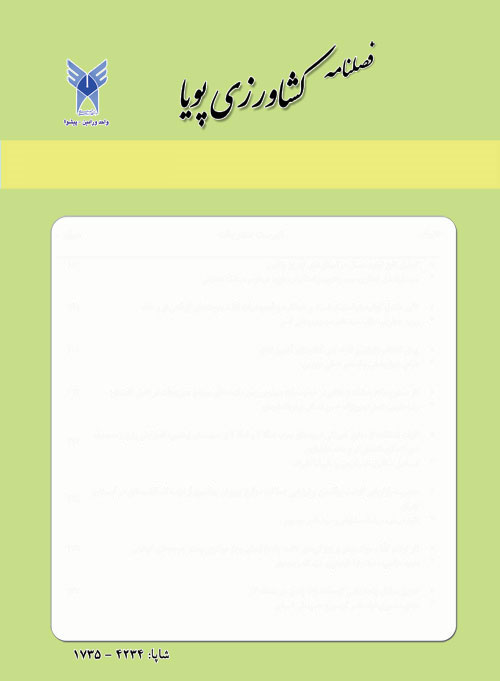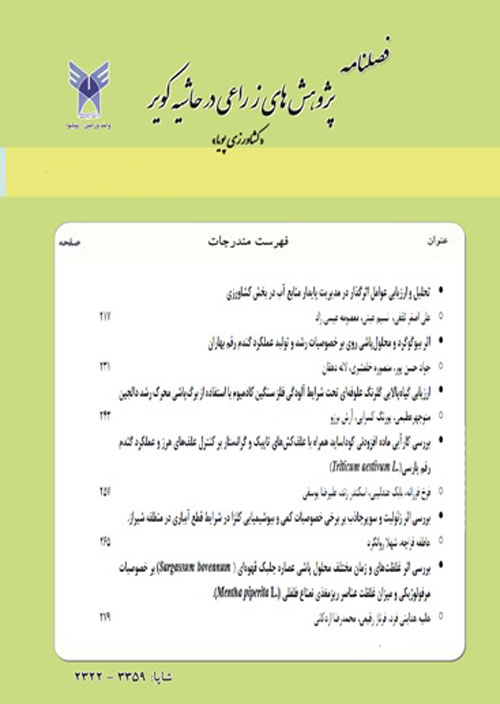فهرست مطالب

فصلنامه پژوهشهای زراعی در حاشیه کویر
سال نهم شماره 3 (پاییز 1391)
- تاریخ انتشار: 1391/08/17
- تعداد عناوین: 8
-
Page 205The goal of this study was to assess the effect of irrigation with wastewater of Bojnourd Petrochemical Mill on nutrient elements and heavy metals uptake in barley plant (cv. Sahand). An experiment was carried out in factorial based on completely randomized design with five treatments and three replications. The treatments used for irrigation were: T1: undiluted wastewater, T2: 75% wastewater and 25% well water, T3: 50% wastewater and 50% well water, T4: 25% wastewater and 75% well water and T5: well water only. Seed of sahand cultivar of barley were sown in pots and at the end of the plant growth, plants were harvested and different micro and macro elements were analyzed in each treatment. Analysis variance of the data showed that the effects of different irrigation treatment on concentration of K and P were significant at the 1% level of probability while their effects on concentration of Na and Fe were not significant. Increase of wastewater ratio, increased the concentration of Zn, Cd, Mn and Cu in barley plants. In general, based on the results of this experiment, irrigation with wastewater of Bojnourd Petrochemical Mill was not harmful for barley and it can be considered as a waste source for irrigation of barley field.Keywords: Barley, wastewater, petrochemical mill, heavy metals, nutrients elements
-
Page 215To evaluate the quantitative traits of thirteen cotton cultivars this study was carried out at Varamin Cotton Research Department in 2007 using a randomized complete block designe with four replications. Cultivars were evaluatre in view of agromorphological traits with an emphasis on earliness and effects of other traits on earliness. Analysis of variance showed significant differences among cultivars for all traits. Cultivars Avangard and Chirpan 539 had the highest and cultivars Opal and Varamin X349 the lowest earliness. Based on seed cotton yield،cultivars wereclassified in to three groups, The first group comprised of eleven cultivars among them B. 557 and NO 200 had the highest fiber percent of 38. 15% and 36. 15% respectively. Cluster analysis using Ward method on Standard traits classified cultivars. Early cultivars such as Chirpan 539 and Avangard were located in this group and cultivars 43259, Varamin X349 in the second group. Generally the results of the present study showed that cultivars differed in different traits specially in earliness and its components. Early cultivars seems to be suitable for locations with short groth periods.Keywords: Upland cotton, earliness, agronomic traits, cluster analysis
-
Page 233Cold strres is on of the limiting factors caussing yield loss of wheat. The objective of the present study was to determine the effects og genotype × environment interactions for LT50 of bread wheat genotypes in field condition in two temperate and cold regions of Iran during 2008-2009 cropping seoson. A randomised complete block design experiment was set up for 22 improved bread wheat genotypes in three replications. Cold tolerance was measured by LT50. The results of combined analisis of variance for LT50 showed significant differences (P≤0.01) among genotypes, environments and genotype × environment intraction. The results also showed that the mean LT50 of all genotypes grown in cold region of Firoozkooh was 3°C more than that of genotypes grown in temperate region of Karaj, indicating the effects of environments on cold tolerance of wheat. These results demonstrate the influence of environment on expression of cold tolerance and highlights the good indicators of cold tolerance in wheat.Keywords: Wheat, LT50, Freezing temperature, Climatic conditions
-
Page 241to determine the relationship of growth indices with yield components in sugar beet, seven monogerm cultivars Rasoul, Shirin, Jolgeh, Gadouk, Zarghan, SBSI001 and SBSI002 were evaluated in a randomized complete block design with four replications at Engineer Abdolrasoul Motahari Research Station, Karaj, Iran. Each plot included six rows of 8m length. The distance between rows was 50cm and the distance between plants after thinning on rows was 20cm. The measurements were conducted on 15 randomly selected plants from the three middle rows of each plot. To compare the cultivars with respect to growth indices such as leaf area index, crop growth rate and relative growth rate, four times sampling from the shoots and roots per plot were carried out with a 14- day interval, the root yield of the cultivars were determined and quality analysis of the samples was conducted in Sugar Technology Lab of Sugar Beet seed Institute. Results showed significant differences among cultivars for root yield and quality and growth indices. Results of correlation analysis showed that with a decrease in impurities such as Na, K and N in roots, the sugar content, sugar yield and white sugar content increased. With increase in specific leaf area, the impurities in roots and mollas sugar was also increased and alkalinity and extraction coefficient of sugar decreased. Further more, leaf area duration had a correlation with leaf area index, shoot dry weight, root dry weight and total dry weight. There fore, in breeding programs, it is advised to look for lines with a low specific leaf area and high leaf area duration.Keywords: Sugar beet, monogerm cultivars, root yield, leaf area index, leaf area duration
-
Page 255To study the effects of super absorbent polymer application on qualitative and quantitative characteristics of corn under water deficit stress, an experiment was conducted as split plot based on RCBD with three replications at research field of Islamic Azad University, Varamin Branch, in 2012. Experimental factors were water deficit stress (normal irrigation, drought stress in stemming phase, drought stress in tasseling phase and drought stress in stemming and tasseling phase) as main plots and super absorbent polymer (lack of super absorbent, 10kg super absorbent and 20kg super absorbent) as sub plots. Analysis of variance showed significant differences for grain yield and grain oil yield under water deficit stress, application of super absorbent and interaction between water deficit stress and application of super absorbent. Grain oil yield and grain yield in normal irrigation and super absorbent polymer treatments were increased 49% and 50%, respectively. In general, application of super absorbent under water deficit stress by decreasing oxidative stress destructive effects, increased qualitative and quantitative characteristics of corn.Keywords: corn, grain yield, super absorbent, water deficit stress
-
Page 265To find the best plant density and study the compatibility of soybean cultivars in water stress condition, a field experiment was performed in randomized complete block design with split-factorial arrangement with 4 replication during 2009. the main plots were to two irrigation regimes (T1=normal irrigation, T2=100mm evaporation from the surface of evaporation basin); sub plots were jointly three levels of plant densities (60, 80 &100 plant per m2) and two soybean cultivars (Williams & mutant clarck).The studied traits were seed yield, harvest index, seed oil percentage and oleic and palmitic acids Contents. The results showed significant differences among different level of irrigation, plant densities and cultivars. The highest values of measured traits were achieved in normal irrigation and the lowest in water stress condition. Increase of plant density from 60 to 100 plant per m2 decreased all the traits. The seed yield and harvest index of cv. Williams was more than cv. Mutant clarck, while seed oil percentage of cv. Mutant clarck was higher than that of Williams. However, palmitic and oleic acids contents were not significantly different in two cultivars. Maximum and the minimum seed yield were obtained in the highest and lowest plant densities respectively. Increased of plant density from 60 to 100 plants per m2, decreased seed oil percentage in both irrigation regimes and both cultivars. Increase of plant density also decreased palmitic and oleic acids contents in both irrigation regimes and both cultivars.Keywords: Soybean, drought stress, plant density, seed oil percentage, harvest index
-
Page 281The growing rate of urban waste products has caused a serious problem and threatening the health of our society. Lack of attention can cause irreparable environmental damage. This study was carried out to determine the effects of combined municipal city waste MSWC with nitrogen fertilizer on cotton (cv. Avangard) characteristics and soil physicochemical properties. The experiment was conducted in the field condition using randomized complet blok design with four replications by split plot experiment at Agricultural and Natural Resources Research center of Tehran Province in Varamin on a fairly loamy soil. The treatments included: Compost at three levels (0, 20 and 40 tha-1) as main plots and nitrogen fertilizer with three levels (0, 100 and 200 kgha-1) as sub plots. The results indicated that soil salinity was increased with application of municipal waste significantly. Data also showed that the highest seed cotton yield, seed yield, lint yield and %lint were obtained by use of 40 tha-1 urban waste compost plus 100 kgha-1 nitrogen fertilizer. Use of 40 tha- 1. MSWC did not effect on soil pH. The results also showed that fiber quality parameters such as fiber lint, Fiber bund strength, fineness and fiber turn out were affected and they showed the highest quality. the organic carbon amount of soil was increased and bulk density was decreased by application of MSWC the amount of.Keywords: Cotton, municipal solid waste compost, nitrogen, salinity, lint yield, qualitative traits
-
Page 293To evaluate The effects of some quantative and qualitative traits and yield of potato and to determine the most high yielding and early maturing cultivar for cold regions, twenty potato cultivars were evaluated in Dashte Mir Agro-Industrial farm located in Khodabandeh, Zanjan province, in 2005. The experiment was conducted in a randomized complete block design with four replications and some traits such as yield, growth longevity, number of main stems per plant, flowering time and skin harding time were measured. Cultivar Agria was considered as control in the experiment. Analysis of variance on data showed significant differences among the cultivars. Arinda and Latuna with high yield, earliness and higher number of stems per plant were determind as the superior cultivars. These two cultivars were also late flowering and skin harding. Correlation between yield and number of stem per plant, growth longevity, flowering time and skin haring time was positive but not significant. Heritability of all measured traits were high. The highest heritability (0.97) was related to flowering time and the lowest (0.69) to the number of main stems per plant. The high heritability of yield can be related to the high genetic diversity amongst the cultivars.Keywords: Potato, yield, growth longevity, earliness, flowering time


